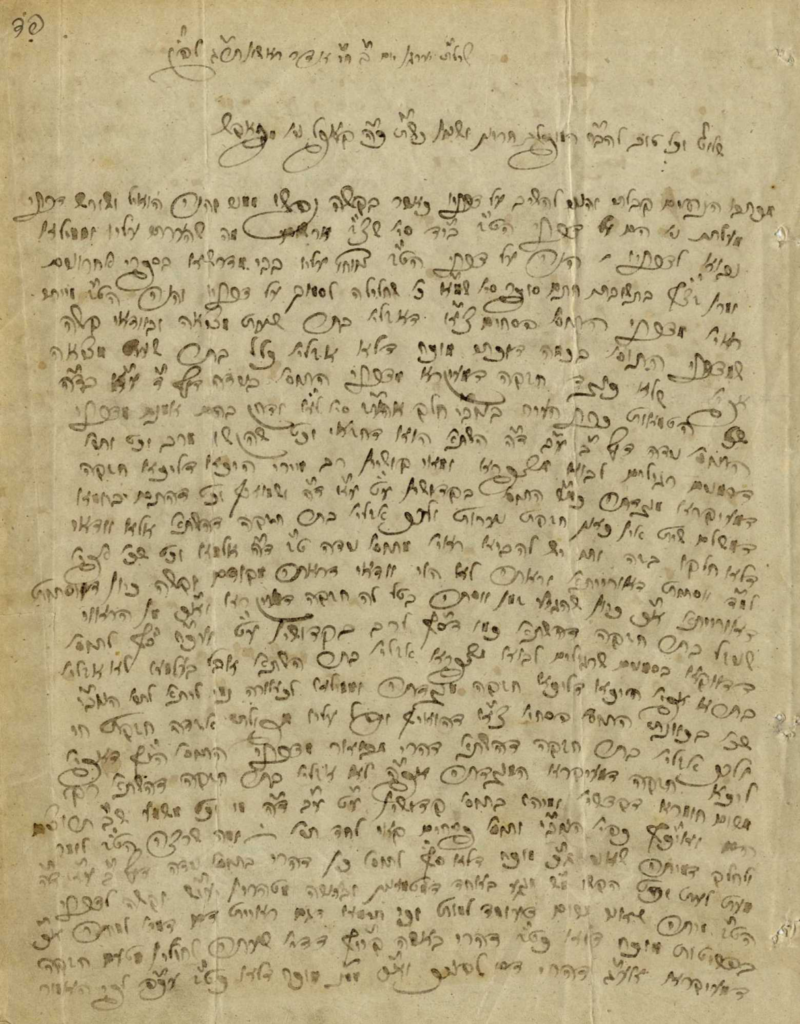
Lengthy halachic responsum handwritten and signed by Rabbi Moshe Schick – Mahara”m Schick. Yergen, 1843.
This is a responsum on the topic ‘chazakah d’meikara v’chazakah d’hashta.’ The responsum was written while he served as rabbi of Yergen by recommendation of his rabbi, the Chatam Sofer, and sent to Rabbi Koppel Singer of Paks, disciple of the Chatam Sofer and the Ktav Sofer, who served as well as rabbi in Kerestir and Lösnich. The responsum was written about three years after the Chatam Sofer’s passing, and right at the beginning of the responsum he quotes his rabbi’s words on the topic.
[3] pages, ink on paper. 22×17 cm. Approximately 100 lines in his holy hand, signed at the end with his name: “The small one, Moshe of Brezová.”
Rabbi Moshe Schick (1807-1879) great disciple of the Chatam Sofer, renowned rabbi of Chust and its rosh yeshivah, greatest adjudicator of Hungary, and leader of faithful Judaism in Hungary. Wrote novellae on Shas, a series of books of responsa, sermons and more.
Fine condition. Aging stains. Slight tears with slight damage to the text, without lack.
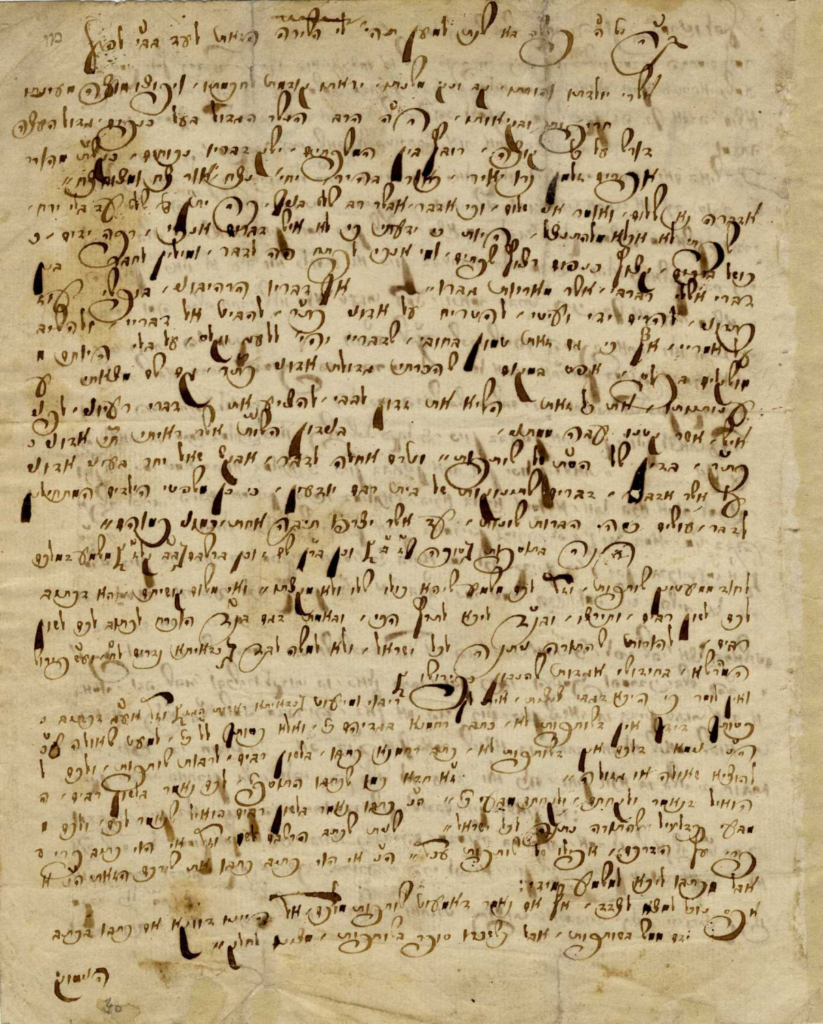
Letter from the GR”A’s grandson, sent to Rabbi Ephraim Zalman Margaliot, author of the Beit Ephraim . Includes a question regarding writing a Torah Scroll in partnership, editing a Torah Scroll and a comment on the response of the Beit Ephraim that was printed later in Yoreh Deah, siman 63.
Rabbi Yaakov Moshe of Slonim (1780-1849) was the son of Rabbi Avraham, son of the GR”A. In his youth, he merited to learn under his extraordinary grandfather. He testified, “I was the most beloved in his eyes, more than the other grandchildren, as my father told me …” He merited to learn Torah and receive guidance from the GR”A.
At the age of 18, he authored a work on Tractate Smachot. He married the daughter of R’ Chaim Yehoshua’s of Slonim, and was supported by him. He was later appointed rabbi of the city. Per his family tradition, he delivered Torah lectures to the public in Slonim and was very involved in clarifying the correct text of Chaza”l and the Early Authorities. He was a prominent redactor of his grandfather the GR”A’s manuscripts, and was very involved in publishing them. Many of his comments shed light on the GR”A’s novellae and his statements regarding the GR”A are completely reliable. Rabbi Yaakov Moshe inherited many of the GR”A’s manuscripts in all realms of the Torah. He organized them and prepared the “Slonim List” – a detailed list of all the GR”A’s writings. This list is the cornerstone of all research on the subject. (Refer to, Yeshurun , year 5, p. 118).
[3] pages, ink on paper. 18×23.5 cm. 67 lines in his hand and with his signature. He added a line on the back of the second leaf: “I forgot the address of Rabbi Zalman M. … I request to give this to his rabbi.”
Fine condition. Minimal aging stains. Two small holes from the acidity of the ink. An expert report confirming the identity of the author is included with this lot.

H andwritten and signed letter by Rabbi Yitzchak Aharon Ettinga. Lemberg [1886?].
The letter concerns charity funds designated for the Sephardic Kollel in Jerusalem [three lines in his handwriting and with his signature].
The gaon Rabbi Yitzchak Aharon Ettinga [1827-1891] was among the greatest Torah personalities of his generation. His father was Rabbi Mordechai Zeev Ettinga, brother-in-law of Rabbi Yosef Shaul Notenhausen, with whom he studied as chavruta for many years, and together composed the well-known book Mifarshei HaYam .
Rabbi Yitzchak Aharon was his father’s primary disciple, and also considered among the generation’s great geniuses in his own right. Halachic questions were addressed to him from all over the country. He was very wealthy, and refused rabbinical offers. He was a disciple of Rabbi Yitzchak Isaac of Zidichov, and later a close associate of Rabbi Chaim of Sanz. He served as ‘Nasi [President] of the Land of Israel in Galicia,’ during which time Rabbi Chaim of Sanz stood at his side. In his final years, he served as rabbi of Lemberg. His responsa were printed in Maamar Mordechai L’Aviv , and in two volumes called Shu”t Mahar”a HaLevi , published after his passing.
[1] leaf. Ink on paper. 9X19 cm. Fine condition. Fold mark.
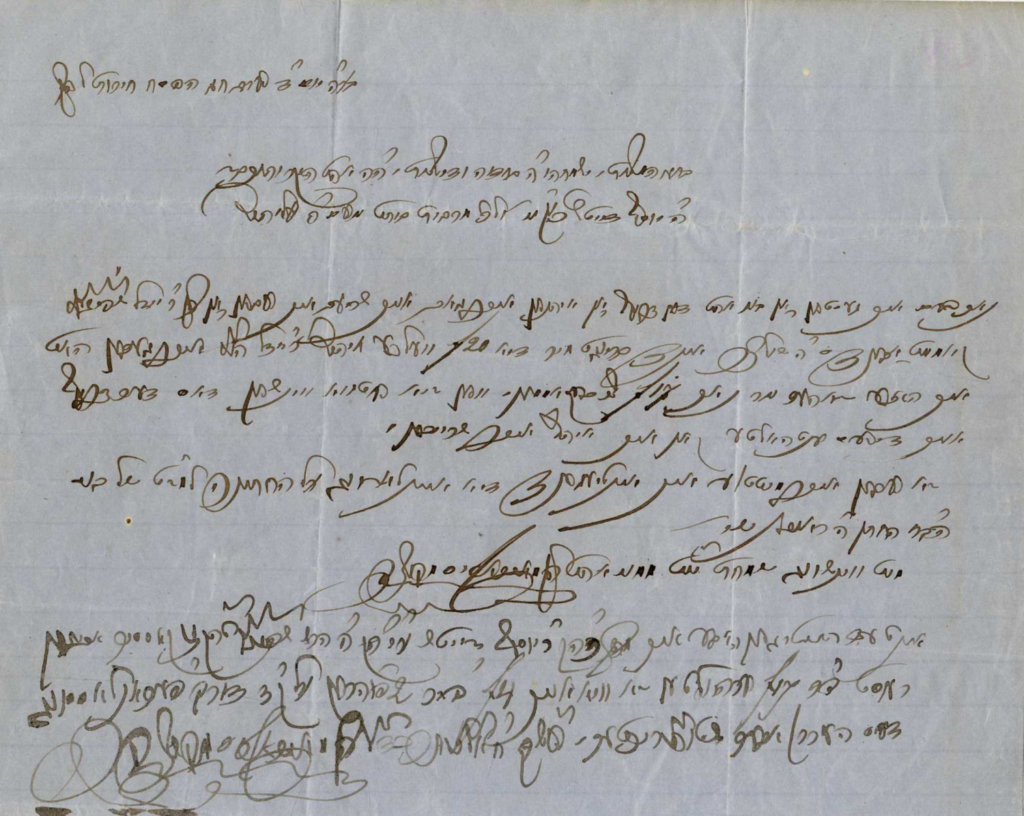
Mazal Tov greetings for an upcoming marriage, written and signed by Rabbi Meir Abeles.
Rabbi Meir Abeles [1806-1887] was born in Nikolsburg. After serving as adjudicator in Kittsee, he was appointed Av Beit Din of in the city c. 1845. He was a beloved disciple of the Chatam Sofer, who refers to him a number of times in his books, and even wrote “whoever his mother gives birth to, should be like him” [Yoreh Deah, siman 325]. In addition, the last letter Pituchei Chotem from the Chatam Sofer was referred to him.
[1] page, 23×18 cm. Ink on paper. Very fine condition. Documentary material included with this lot.
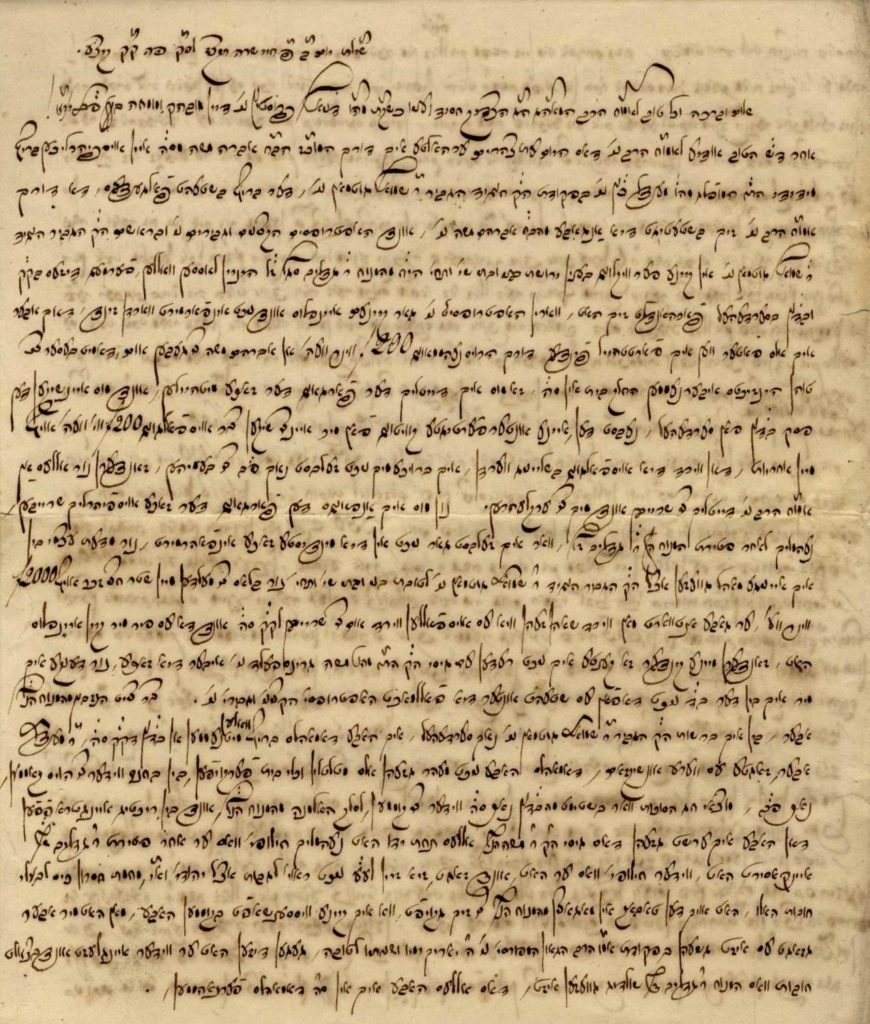
“… ואפיריון נמטיה בהשתחוויה/ לכבוד הנשר הגדול בעל כנפים/ הרב הגאון העצום … לכל בית הגולה … בדורו יחיד… רשכבה”ג משה סופר אב”ד ור”י פ”ב יע”א…”
“… In honor of … the great, genius rabbi of the entire diaspora, once-in-a-generation … Moshe Sofer, Av Beit Din and Rosh Yeshivah, Pressburg.”
A long letter with Rabbi Kalman Segal of Pressburg’s handwriting and signature, to his father-in-law, Rabbi Daniel Prostez, Av Beit Din of Pressburg. The letter’s close contains regards to the Chatam Sofer.
The recipient, Rabbi Daniel Prostez, was the Av Beit Din of Pressburg during the Chatam Sofer’s time, and served as his close associate, assisting him to lead the Pressburg community.
[3] pages. Ink on paper. 19×23 cm. Handsome, clear handwriting. Broken wax seal.
Very fine condition. Fold marks.

Long and in-depth halachic discussion regarding the laws of tefillin, handwritten and signed by Rabbi Simchah HaLevi Bamberger. 1855.
Interesting letter in which Rabbi Bamberger discusses his father’s words in the well-known book Melechet Shamayim on scribal halachot, where he analyzes the Pri Megadim and Magen Avraham’ s question regarding tefillin made according to kosher standards but later disqualified. Similarly, the rabbi rules according to Maimonides’ opinion that letters should be punctiliously written exactly as in a Torah scroll, that a scribe should be cautious in writing a mezuzah’s letters, and also on the issue of the disqualification of letters in a Torah scroll.
Rabbi Simchah HaLevi Bamberger [1832-1898] was son of the ‘Wurzburg Rebbe,’ Rabbi Yitzchak Dov Bamberger. He served as rabbi of Colmar, and subsequently in 1855 as rabbi of Fishach for 26 years. After Rabbi Avraham Adler’s passing in 1882, he began service as rabbi of the Aschaffenburg community. He authored Pekudat HaLeviim , Avodat HaLeviim, Chinuch Lena’arim and more.
[2] leaves [three pages with writing]. Ink on paper. 20×13 cm. Slight tear pasted with no lack at the end. Fine condition.
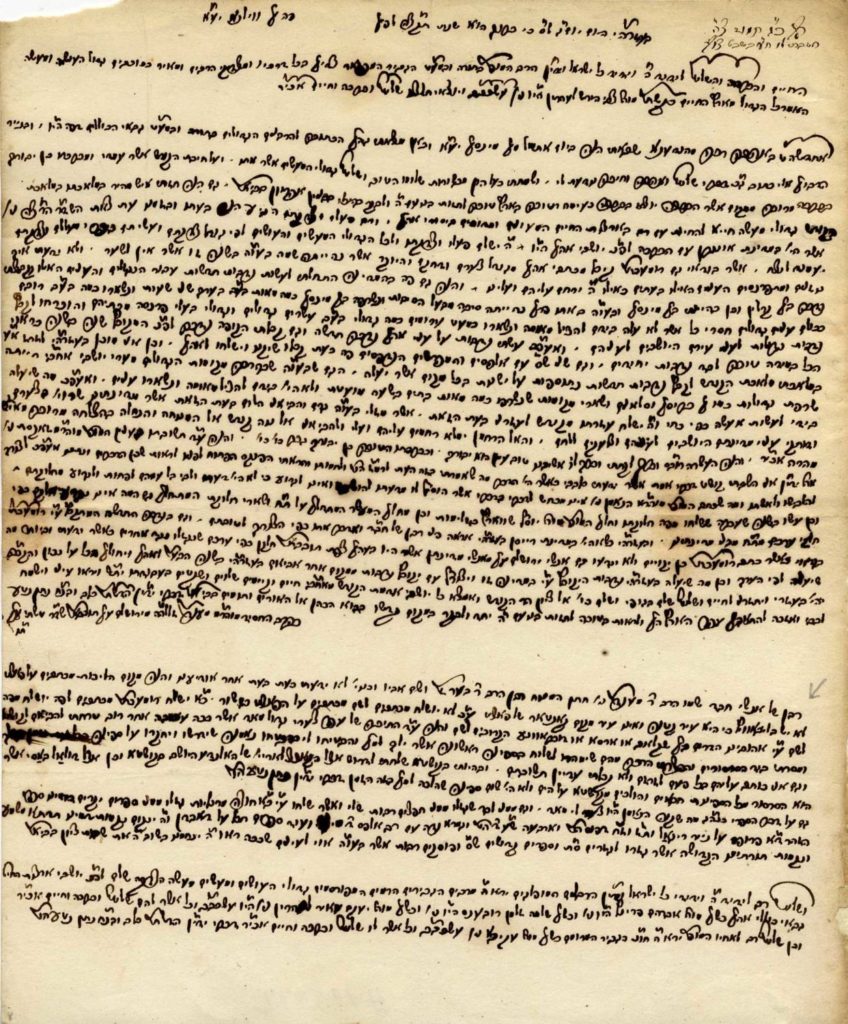
Historic letter written in the hand of Rabbi Natan Nota, who succeed his father’s position as head of the Ashkenazic community in Jerusalem, sent to Rabbi Tzvi Hirsch Lehren, head of the Clerks and Administrators [ ‘פקידים ואמרכלים’ ] in Amsterdam. Vilna, 1835.
Rabbi Menachem Mendel was an outstanding disciple of the GR”A. He headed the Ashkenazic community in Jerusalem and, with much self-sacrifice, created the foundation for the community and its institutions. He was in close contact with the rulers in the country and worked with rabbis and activists of the era, who admired and appreciated his efforts.
When his father passed away, Rabbi Natan Nota was the natural successor to lead the community. In this letter, Rabbi Natan Nota provides Rabbi Tzvi Hirsch a description of the difficult conditions of his people in the Land of Israel. He also writes about his journey abroad.
This rare letter highlights a few previously unknown facts:
The very fact that he traveled to Russia for the kollel is unknown from any other source. In addition, he gives a report about the fundraising mission of Reb Tzvi Hirsch [?] in Hungary, a mission that caused a rift between the chassidim and perushim, with Yismach Moshe and Chatam Sofer standing on opposing sides of the divide. Another discovery is that the Clerks and Administrators planned on sending him funds through Rabbi Menachem Mendel, the Tzemach Tzedek of Lubavitch, who was the rabbi of the Chabad chassidim in 1828 and was a supporter of the fund. It seems that the Clerks and Administrators were not familiar with this great rabbi and asked Rabbi Natan Nota if it was appropriate to send funds through Lubavitch. Rabbi Natan Nota suggested that they should not send the money through Lubavitch, but through “Perushim” cities.
Rabbi Natan Nota primarily describes his trips to raise funds for the Yishuv in the cities of Lithuania and White Russia: Karlin, Minsk, Brisk, Slonim and more. Despite their financial straits following big fires in which “a few hundred homes were burnt in a short time, and they couldn’t save anything …” they donated more than they really could.
In one line, Rabbi Natan Nota alludes to a terrible episode that occurred in the summer of 1834:
After the Egyptian ruler Muhammad Ali captured Palestine in 1831, he instituted a mandatory draft to the Egyptian army amongst the Arab population as part of his modernization campaign. This draft was bitterly opposed by the Arabs (who were loyal to the Ottoman Empire). In the month of Nissan, they declared a revolt in Nablus and armed groups of rebels descended on Jerusalem and started pillaging the Jewish community in the city.
From Judea, they went up to the Galilee, pillaging everything in their path. Rabbi Yisrael of Sklow, who then lived in Safed, gives us a chilling description of the episode: Their homes were pillaged and destroyed, holy sites were vandalized and defiled. From tefillin, the rioters made straps for their sacks and horses; from the prayer shawls they made belts; and from the parchment of the Torah scrolls they made shoes. Old men and women who fled to the Perushim’s study hall for refuge were cruelly beaten, and in one of the synagogues the women were raped on the fragments of the Torah Scrolls.” Rabbi Natan Nota’s description parallels Rabbi Yisrael’s terrifying words.
[1] leaf. Ink on paper. 26×22 cm. Minimal aging stains. Fine-very fine condition.
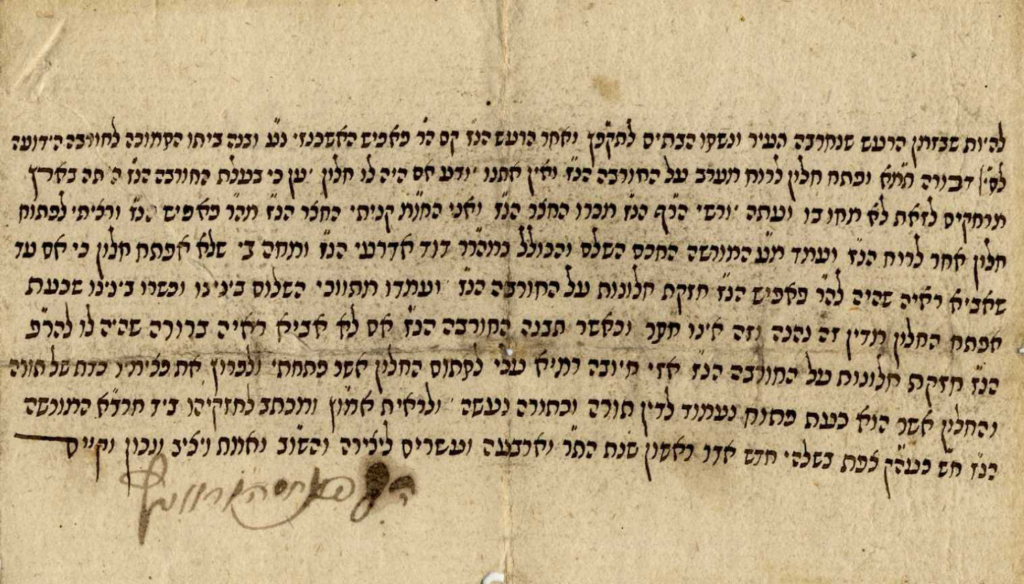
Financial document signed by Rabbi Pinchas Horowitz of Broyde-Safed, [1864]. Scribal hand.
The document discusses laws concerning neighbors. One person made a window facing a ruin whose owner had been far away at the time. Now, the owner claims that his neighbor had no permission to make this window and has no tenure to a window in this direction. The neighbor agrees to bring proof that he does have tenure to opening a window in this direction. Signature of Rabbi Pinchas Horowitz, confirming the matter, in the margin.
Rabbi Pinchas Horowitz , grandson of the author of Hafla’ah , moved from Broyde to Safed. His daughter, Rebbetzin Miriam, married Rabbi David Shlomo Tzvi Biderman of Lelov [Reb Duvidel of Lelov]. The story is told that soon after Rabbi Horowitz resettled in Safed, he heard about Admor Elazar Mendel of Lelov [father of Reb Duvidel] and traveled to Jerusalem to visit him. He immediately felt a strong bond with the Admor and that is how the shidduch between their children came about.
[1] leaf. Ink on paper. 12×16 cm. Scribal hand. Fine condition. Fold marks.
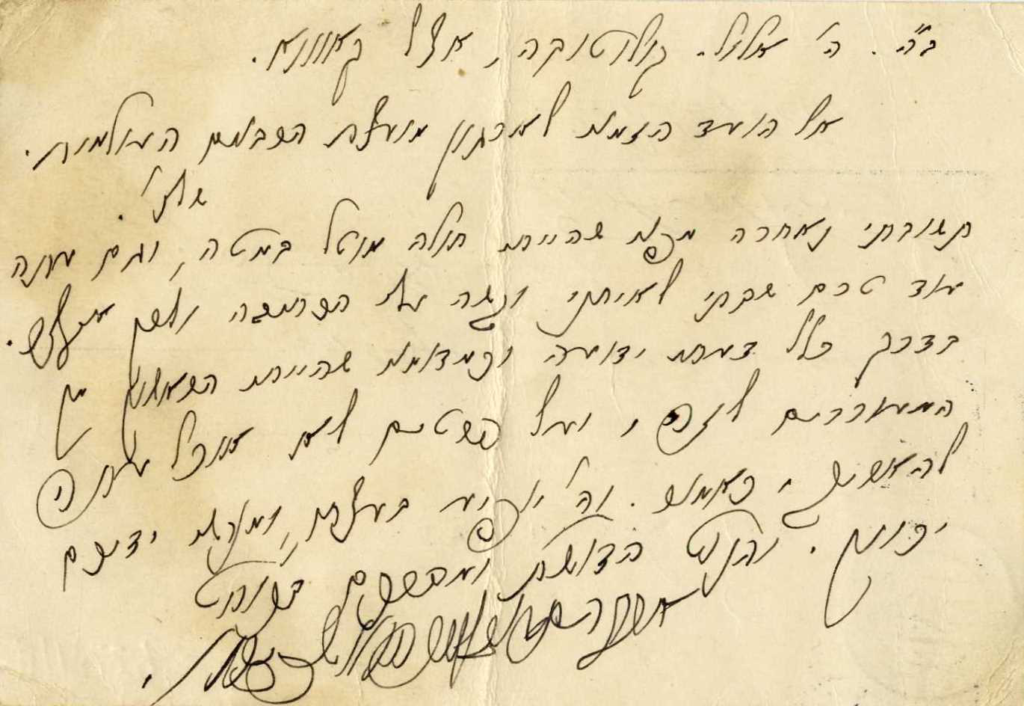
Important letter written and signed by Rabbi Avraham Dov Kahana Shapira, Kovno, 1936, regarding the establishment of an international rabbinical council.
The letter was sent to the “Temporary Committee for Arranging an International Rabbinical Council,” which began operating in Tel Aviv. After apologizing for the late reply, ‘I was sick and laid up in bed, and I have not yet fully recovered,’ Rabbi Shapira writes: “In general, my opinion is known, and it would seem that I was the first to raise this, and as for the details, I cannot write at length right now …” He referred to his initial support for the establishment of an international rabbinical council.
At the time, attempts were being made to establish such an international body. Rabbi Menachem Mendel Kasher was one of the leaders of the initiatives, and this letter seems to indicate that the author of Dvar Avraham supported its establishment. For various reasons, the council was never created.
Rabbi Avraham Dovber Kahana Shapira [1870-1943] was the rabbi of Kovno and author of Shu”t Dvar Avraham . He was among the most prominent rabbis in his time. He studied in the Volozhin yeshivah and was known as the “Prodigy of Kobryn.” He was the son-in-law of Rabbi Yeruchem Yehudah Leib Perlman – the “Gadol of Minsk.” In 1896, he was appointed rabbi of Smolavitch, where he authored both sections of his Dvar Avraham . The work was widely popular in the yeshivah worlds in Lithuania and Poland and, within a short time, its author was recognized as one of the leaders of all of European Jewry. In [1913], at the age of 43, he was appointed rabbi of Kovno, capital of Lithuania. For about thirty years, he was tirelessly involved in the communal needs of Lithuanian Jewry. Amongst other accomplishments, he was the founder of the Agudat HaRabbanim in Lithuania and its honorary president. He passed away in the Kovno ghetto in 1943, after a long, difficult illness.
[1] postcard. 10×14 cm. Fine condition. Fold mark along the length of the postcard. Light stains.
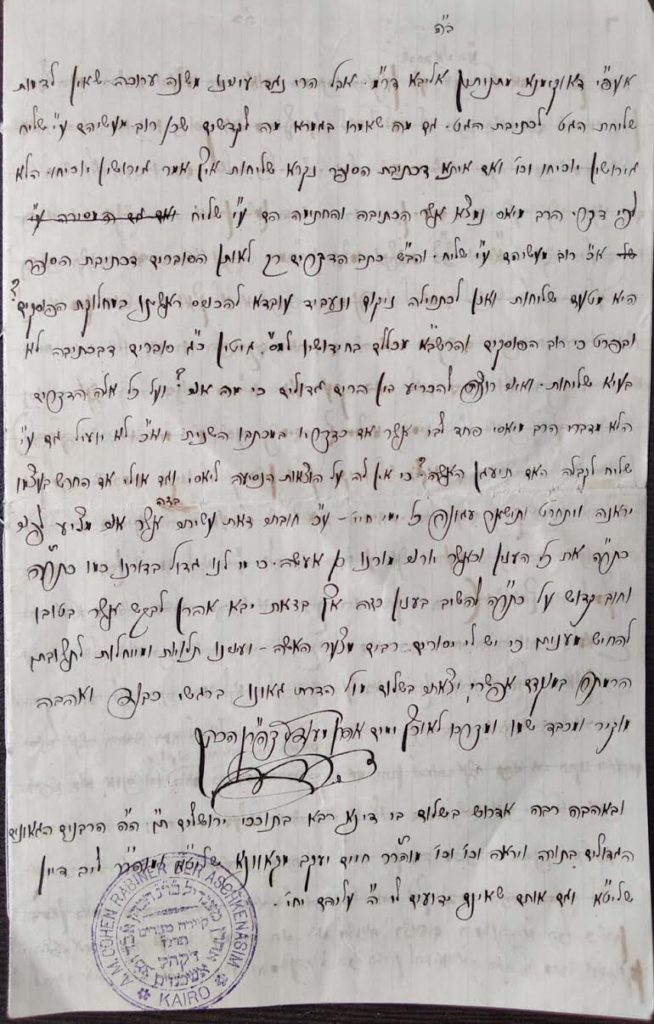
“….There is no great person in our generation like his honor, and it is a holy obligation of his honor to answer this type of question.”
Lengthy letter written and signed by Rabbi Aharon Mendel, Rabbi of the Ashkenazic community in Cairo, with a question regarding an aguna whose deaf husband was in Romania – sent to Rabbi Yosef Chaim Sonnenfeld. Cairo, 25th of Tammuz, 1905.
Rabbi Ahron Mendel presented a question to Rabbi Sonnenfeld regarding a poor woman in Cairo, who had a husband in Jassy, Romania that she wanted to divorce. On top of it all, the husband was deaf. Rabbi Mendel offers an in depth discussion regarding the permissibility of sending a deaf person a get.
Rabbi Ahron Mendel was born in 1866 in Tiberias. He was a confidante of the Sephardic rabbis there. In 1894, he was appointed Ashkenazic rabbi of Cairo. He authored the Semichat Chachamim, in which he advocates renewing “semicha” ordination and founding a Sanhedrin. A result of this initiative was the World Congress of sages in Krakow in 1903. He passed away in 1928.
8 pages, 13×21 cm. All in his hand and with his signature and stamp.
Very fine condition, nice, legible hand.
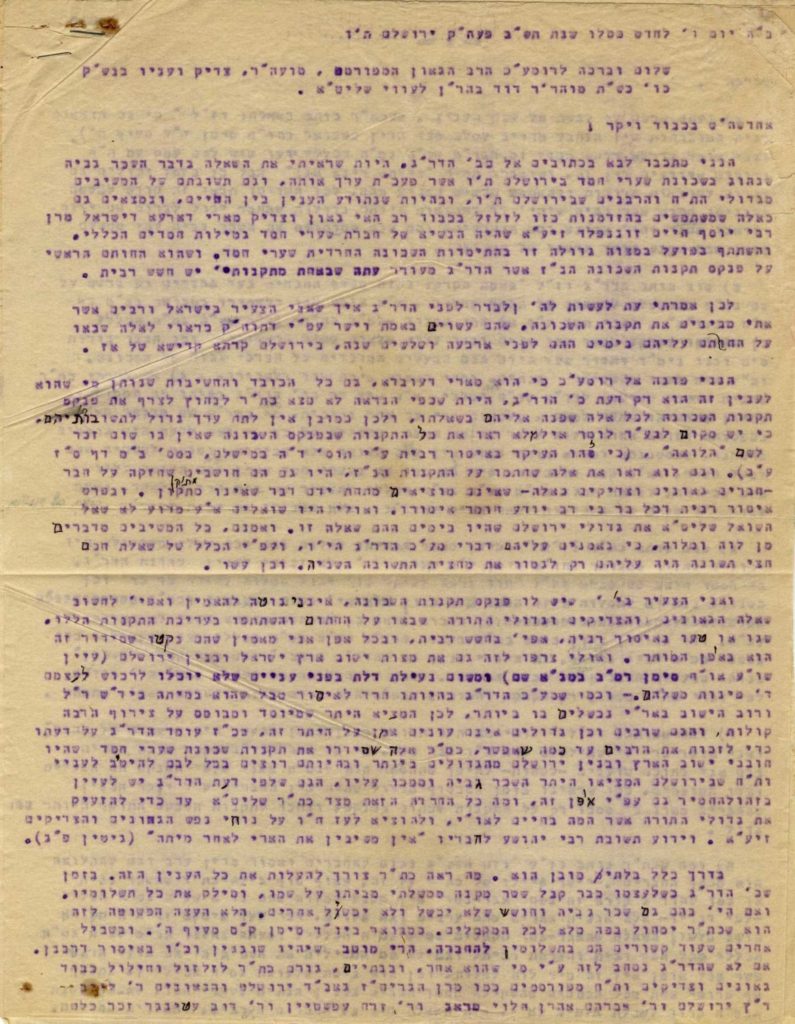
Long letter signed by Rabbi David Bahara”n (son of Rabbi Nachum) Loewy, and a letter with an answer by Rabbi Eliyahu Nachum Porush Glickman.
A controversy and polemic was started in Jerusalem during the 1901, when Rabbi Binyamin Cohen accused “Gemilut Chesed Shaarei Chesed” (the first gema”ch in Jerusalem) of fining those behind in making house payments, a transgression of the Torah prohibition against taking interest. The Gemach Shaarei Chesed was a very important institution in Jerusalem, then headed by Rabbi Yosef Chaim Sonnenfeld, and the protest that came out against him caused a storm, since the practice of collecting fines began during his leadership.
Rabbi David Baharan, one of Jerusalem’s righteous leaders, put the matter in writing. Before us are the two large typewritten pages in which he refers the halachic question to prominent rabbis, while apparently favoring prohibition. Due to the question’s weightiness, Rabbi David signed his name on each page.
Conversely, Rabbi Eliyahu Nachum Porush Glickman (mashiach of Etz Chaim and one of the greatest activists in Jerusalem), son of Rabbi Shlomo Zalman Porush, founder of Gemilut Chesed Shaarei Chesed, countered the appellants. In his letter to Rabbi David Bahara”n, he begins by saying that the gemach’s president was Rabbi Yosef Chaim Sonnenfeld, who was actively involved in management, and the chief signatory on the book of regulations that the appellants were presently challenging with charges of suspected interest. In his remarks, he hints in a dignified manner that Rabbi David Bahara”n may have been dragged into the matter by someone else, and adds that the controversy harms Rabbi Yosef Chaim Sonnenfeld as well as other gaonim and tzaddikim such as Rabbi Avraham Aharon HaLevi Prague, Rabbi Zerach Epstein, among others. In a very long letter he reaches the conclusion that the regulation does not transgress the prohibition of taking interest whatsoever.
This polemic was also shared by the Gaon of Teplik, Rabbi Shimshon Aharon Polanski, and Rabbi Tzvi Pesach Frank, who sided with the prohibition. See also Har Tzvi Rishmei She’elah , Yoreh De’ah , page 97.
2 folio leaves, Rabbi David Bahara”n’s letter
5 leaves, Rabbi Eliyahu Nachum Porush’s letter
Fine condition. 15×20 cm.
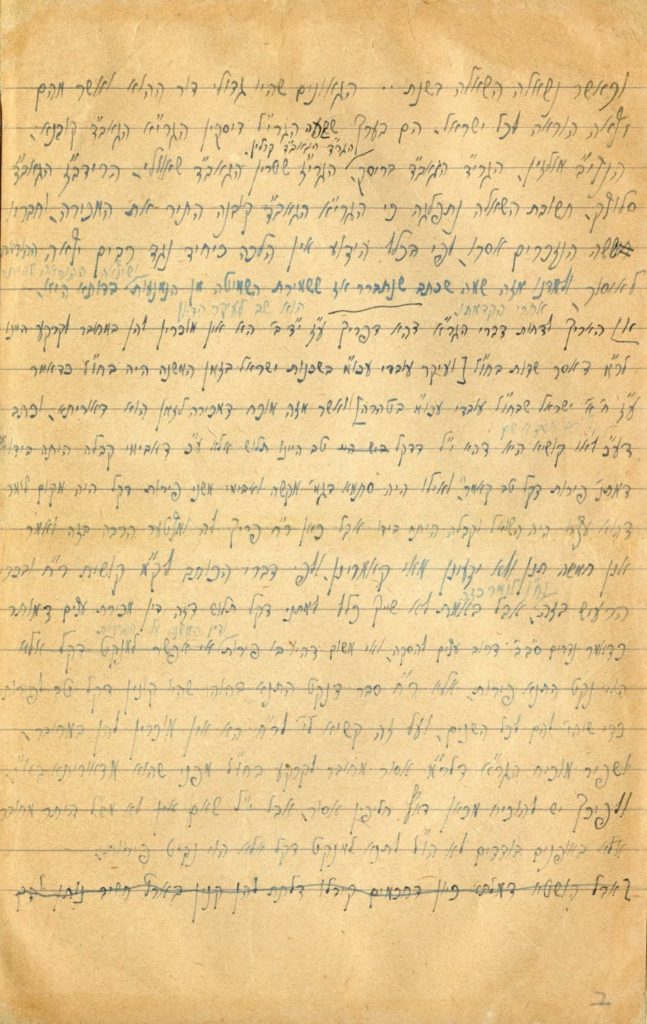
The heter mechirah controversy:
With the renewal of the Jewish agricultural settlement in the Holy Land, when we were privileged with His help to take hold of the Holy Land with plantations of fields and vineyards, the issue of shemittah came to the fore. Before the seventh year, which was 1888, the gaons and rabbis of the Holy Land rejoiced leading up to the fulfillment of the sabbatical of the Land by its children-its builders, those who returned from exile, and they entirely disregarded those who demanded searching for some type of dispensation with various schemes to absolve themselves of this commandment. However the ‘Baron”s clerks and the leaders of ‘Chibat Tziyon’ turned to the rabbinical leaders of Poland, and after they presented them with the danger of extinction of all the colonies and the new settlement should shemittah be observed, the rabbis considered this and found dispensations. Rabbinical leaders of Jerusalem and the majority of rabbinical leaders of Lithuania opposed the dispensation and did not accept it. Beginning in shemittah 1889 until this day, every seven years the validity of this dispensation again arises.
Background to the Chazon Ish’s responsum – and the discovery:
In the Kerem Tziyon booklet (booklet 3, Jerusalem 1936), a long article by the gaon of Jerusalem, Rabbi Tzvi Pesach Frank, was printed, in which he sided with those who permit the dispensation. The primary proof brought by the rabbi was “I saw two books just published by the study hall, and both as one cancel the dispensation, rejecting it with both hands, and the leaders of the generation who allow it appear to them to be mistaken in their study.” One of the books intended by Rabbi Frank is the Chazon Ish on Tractate Sheviit which was published then, and in the body of the article, he mentions it explicitly. In 1944 Rabbi Kalman Kahane published his Hilchot Shemittat Karkaot which concludes with the article “Birur Halachah” where he disputes Rabbi Frank’s article and vehemently rejects his words – according to this manuscript, it turns out that most of the article was penned by the Chazon Ish who drew his sword against those who support the heter mechirah. What was known until now, was that apparently the Chazon Ish transmitted his words for publication to Rabbi Kahane so that they would be published anonymously, and now it has been clearly revealed that almost all that was printed there is actually the word of the Chazon Ish himself. Before us is the responsum which continues over seven pages, in which the Chazon Ish honed his pen and responded sharply, wrote and erased, added and changed, as a warrior in the battle of Torah.
The reaction of the Chazon Ish is divided into three parts:
1) Which facts were presented to the rabbis and how they checked them. Here is a small segment: Rabbi Tzvi Pesach Frank writes at the beginning of the article: “It has become clear for a number of reasons that it is almost impossible that all the inhabitants of the Land will observe shemittah.” The Chazon Ish responds to this: “The method of checking has not been fully clarified, whether it is possible to observe the seventh year or not, the simple basis of the test is whether there is fear [of G-d] in this place. Hence it must not be said that this test showed that it is impossible.” Rabbi Tzvi Pesach Frank wrote, “The question was presented to the leaders of the generation and they decided to permit it,” to which the Chazon Ish responded, “Where are the sources for all these words that are written, and why have we not merited knowing the names of those who testified before the writer … they surely gave him the names of the members of the investigative committee which was set up by the gaons of the generation … why would the writer ignore all this and write as one of the authors whose words are written without any responsibility …”
2) Who were the rabbis who permitted, and what was the reasoning of the rabbinical leaders: the Chazon Ish writes: “The gaons who were the rabbinical leaders of that generation, who instructed the generation are about seven: The gaon Rabbi Yehoshua Leib Diskin, the gaon Rabbi Yitzchak Elchanan – Av Beit Din of Kovno, the Netzi”v of Volozhin, the gaon Rabbi Yosef Dov of Brisk, the gaon the Av Beit Din of Karlin, the gaon Rabbi Y. Z. Stern – Av Beit Din of Shavel, the Ridba”z – the Av Beit Din of Slutzk. The response to the inquiry was split; the gaon Rabbi Y. E. of Kovno permitted the sale, and the other six mentioned forbade it. According to the well-known rule, halachah is not established according to the individual against the many, hence instruction was disseminated to forbid it. We learn from this that what was written as to what was clarified then – that observing shemittah is impossible – is fabricated.”
3) Basis for the dispensation. The Chazon Ish covers all the halachic topics relevant to the substance of the dispensation: whether there is acquisition by a gentile to expropriate, etc., whether there is a difference between sale for a short or long period, the prohibition of selling the Land of Israel to gentiles, sale via emissary, financial loss, etc. He rejects them one by one and concludes: “The sum of the matter, when all has been considered, instruction has been given to forbid it by the majority of the generation’s gaons. Their word is as embedded nails, clearly decided, and there is no place for doubting their truth, because their words are aligned and enlighten all intelligent people, and sheviit is conducted in our times …”
The Chazon Ish’s responsum was printed, as stated, in the aforementioned Hilchot Shemittat Karkaot , with many omissions and in a different version, possibly according to a different manuscript, in Chason Ish Shu”t V’Chiddushim (Bnei Brak 2016) siman 351.
Before us is the complete and continuous responsum in the Chazon Ish’s own handwriting, with no changes to language or style – This precise format has never been printed!!
This is aside from the essence of the discovery that all that Rabbi Kalman Kahane wrote in Birur Halachah at the end of his book, is actually comprised of quotations from the Chazon Ish’s responsum, as he was requested by the Chazon Ish to conceal his authorship of what was written.
7 pages. Ink on notebook paper. 22×14 cm. 21 lines written by his holy hand on each page.
Fine condition. Professional restoration in the white margins. The ink is faded in a number of places, mainly on the last two pages. Magnificent new leather binding.
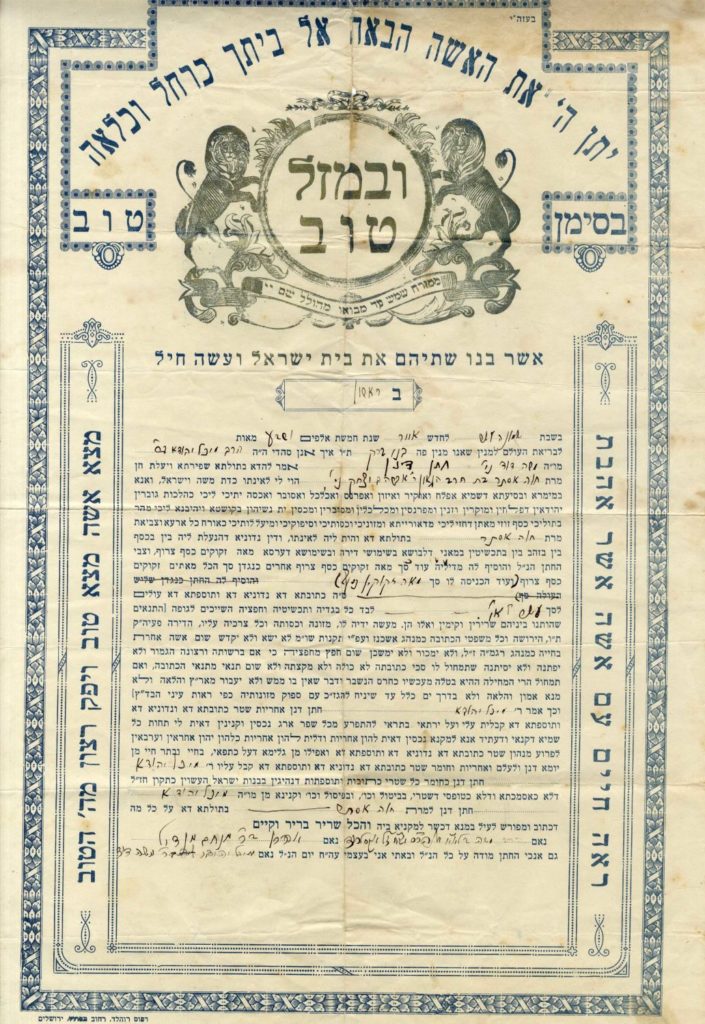
Ketubah of Rabbi Michel Yehudah Lefkowitz upon his marriage to his wife, Rabbanit Chava Esther, daughter of Rabbi Avraham Yitzchak Gershonowitz , Rosh Yeshivah of Tiferet Tzion. Bnei Brak, 1947.
Rabbi Michal Yehudah Lefkowitz’s wedding took place in Bnei Brak on Lag BaOmer. The Chazon Ish was behind the match. The wedding was delayed due to financial difficulties, and materialized through the Chazon Ish’s support.
Rabbi Michel Yehudah Lefkowitz [1913-2011] was a leader of the Lithuanian “Yeshivah” community. He was a prominent disciple of the Chazon Ish, a member of Degel HaTorah’s Council of Torah Sages, and Rosh Yeshivah of Ponevezh L’Tzeirim for sixty years in succession. He taught thousands of students, including rabbis, rosh yeshivahs and famous Torah scholars. After his marriage, he was appointed lecturer in Yeshivat Tiferet Tzion, where his students included Rabbi Chaim Kanievsky, Rabbi Nissim Karelitz, Rabbi Meir Tzvi Bergman and Rabbi Dov Tzvi Karlenstein.
[1] printed sheet of paper. 47×31 cm. Handwritten additions: names of bride and groom, place, time, ketubah sum, witnesses’ signatures, and signature of the groom, Rabbi Michel Yehudah Lefkowitz.
Moderate-fine condition, fold marks and tears along the length of the fold marks, minimal aging stains.
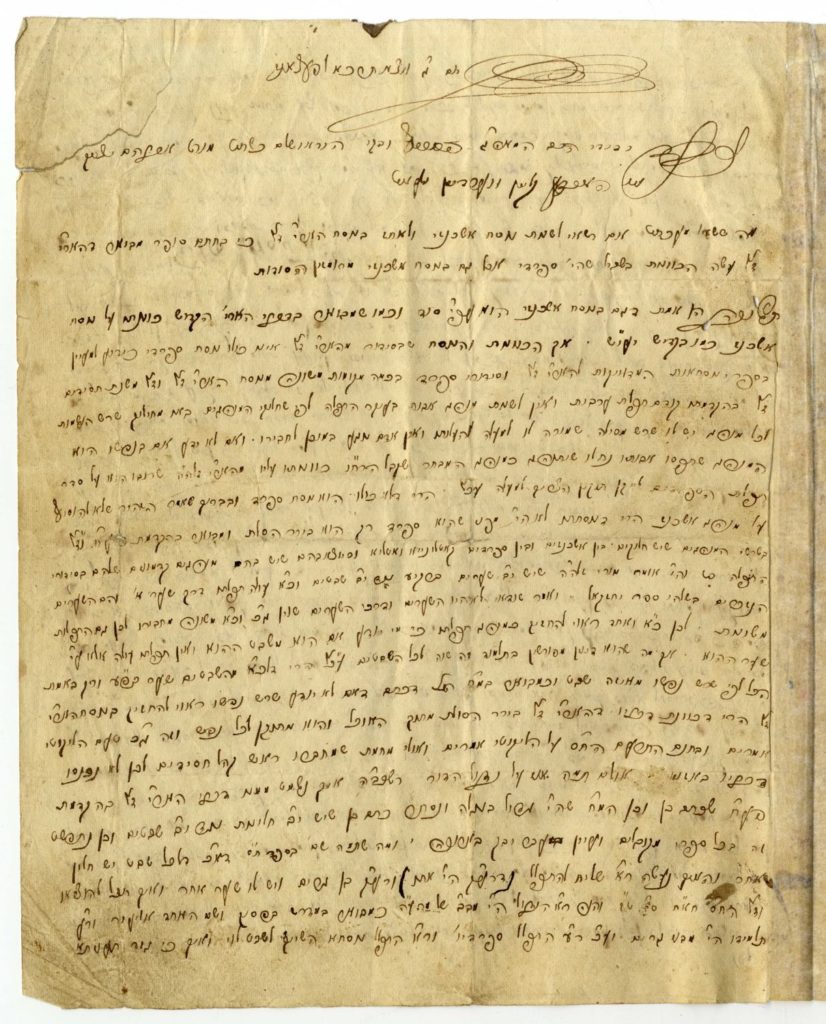
“… My words are the low point of the situation, submitting to the disciples of the Ba’al Shem Tov, to comprehend their holy words, the small one, Chaim Halberstam.”
Handwritten halachic responsum, signed in the holy hand of Admor Chaim Halberstam of Sanz, author of Divrei Chaim . Sanz, 1861.
Three pages crammed with clear eastern-European rabbinical script written by one of the scribes who served the author of Divrei Chaim . Between the lines, there are handmade revisions and additions written by the author of Divrei Chaim himself. At the conclusion of the letter, there is an additional line in his hand with his signature.
This responsum, discussing the prayer nusach (version) and the preference for “Nusach Ar”i” over “Nusach Ashkenaz,” was printed in Rabbi Chaim Halberstam’s famed work, the Divrei Chaim responsa, section II, siman 8. However, precise comparison between the original text and the printed version reveals dozens of differences – sometimes significant ones – between the two. This emphasizes the double significance of this autograph discussing a halachah that is close to the heart of the nation.
As soon as chassidut emerged in the 18th century, discussions arose regarding the version of prayer. One of the prominent features of the chassidic movement is expressed in this switch from “Nusach Ashkenaz,” the customary version used in Europe, to the “Nusach Ar”i,” also called “Nusach Sephard.” Nusach Sephard prayer books are based on Nusach Ashkenaz with some changes and additions to prayers. This was all influenced by the chassidic movement, which viewed the Ar”i’s kabbalah and his intentions in prayer as of extreme import – to the extent that they used it to change the version of prayer they had traditionally followed over hundreds of years. The first prayer book printed by the chassidim was the Siddur HaRav MiLiadi, which was arranged according to the Nusach Ar”i (Sklow, 1803). A Nusach Sephard siddur was printed in the Ukraine, Poland, and Galicia that was very different than the Siddur HaRav MiLiadi , corresponding to the opinions in the various chassidic courts.
The switch from Nusach Ashkenaz to Sephard triggered a sharp polemic between the chassidim and their opponents, and even amongst the chassidic courts. One of the primary claims in the polemic opposing chassidism was this switch in version of prayer, a switch that opposed halachah and that many believed was even contrary to the opinion of the Ar”i himself. This claim was mentioned in the first polemic publications, such as ” Zamir Aritzim V’Chorvot Tzurim,” (Oleksinetz 1872): “Our brothers of the house of Israel, did you not know that new things have come that our fathers did not know, that a suspicious faction has joined together […] and they are making societies amongst themselves and their religion is different than all of the Jewish Nation in their versions of prayer.” The first one to appreciate the importance of adapting the Nusach Sephard changes into the Ashkenazic siddur was Rabbi Dov Ber, the Maggid of Mezeritch, disciple and successor of the Baal Shem Tov, who viewed this issue from a kabbalistic level. He determined: “And the G-dly Ariza”l, to whom paths of the heavens were known, taught wisdom to the nation for those who did not recognize it … and he instituted the service compiled from a number of versions as known to experts. Therefore, everyone should grasp the path of the Ariza”l, which is good for every soul” ( Maggid Devarav L’Yaakov, Korzec, 1884, leaf 22).
Despite this, there was no consensus amongst halachic personalities regarding these changes to the nusach. One of the basic positions on the issue was expressed by a prominent adjudicator of the 18th century, Rabbi Moshe Sofer, who wrote in his S hu”t Chatam Sofer (Orach Chaim 1, siman 15) that the Ar”i wrote his intentions based on the Sephardic version of the prayer book, because he was Sephardic, and they do not match with the Ashkenazic prayer books. Therefore, only unique, rare personalities have the ability to make these changes: “And when the G-dly light, the Ar”i ztz”l researched and revised because he knew the content, he placed in his siddur everything correctly and revealed mysteries of the Sephardic version because he was Sephardic […] and my teacher the gaon … Natan Adler ztz”l led the prayers himself in the Sephardic version in the Ar”i’s prayer book, and the same is true of my teacher the gaon, the author of Hafla’ah , ztz”l. They were the only ones who prayed in Nusach Ar”i, and no other people in the minyan recited anything other than the Ashkenazic […], because someone who doesn’t know, can’t change our nusach.”
The Chatam Sofer’s clear position stood before the Divrei Chaim when he wrote this famous responsum. In the responsum, he discusses the Chatam Sofer’s claims one by one, while he clarifies that he wasn’t trying to disagree with the Chatam Sofer: “I am not an expert [even] in his mundane discussion, only what I saw and received from the mouths of the holy lofty great ones in the revealed and the hidden .” At the conclusion of the response, the Divrei Chaim determines that, “anybody whose soul is fine can rely on the leaders of the generation, the holy ones, who switched from Nusach Ashkenaz to Nusach Sephard. Since the Besh”t descended and grasped the Nusach Ar”i, everyone who believes in the Besh”t and his disciples is worthy of grasping the Nusach Ar”i and shouldn’t budge from it.”
The polemic surrounding the version of prayer didn’t end with this responsum. It generated the sharp rebuttal of Maharam Schick, disciple of the Chatam Sofer. In his responsa (Orach Chaim 43), he strongly opposes the Divrei Chaim’s determination and concludes: “and I am very astonished that the gaon of Sanz agreed to the opposite, that it is permissible to change.” In contrast, the author of Minchat Elazar of Munkacs argued against the position of the Maharam Schick and supported the Divrei Chaim.
Rabbi Chaim Halberstam of Sanz (1797-1876) was the rabbi of Sanz, Galicia and founder of the Sanz chassidut. He was one of the prominent Jewish leaders in 19th century Eastern Europe and was a disciple of Rabbi Naftali Tzvi of Ropshitz and of Rabbi Tzvi Hirsch of Zidichov. Most of his sons and sons-in-law were Admors, the most famous being his son, Rabbi Yechezkel Shraga Halberstam of Shinova. His progeny led many chassidic courts, such as Sanz-Klausenberg, Bobov and Stropkov.
At the same time, Rabbi Chaim was also famed as a halachic adjudicator and responder. He received rabbinic ordination from Rabbi Ephraim Zalman Margaliot of Brody and held halachic correspondence with the leading rabbis of his generation. He is noted for his stringent opinions regarding mikvaot; he sharply opposed use of machine matzah and tzitzit spun by machine. A few of his halachic rulings stormed the chassidic world, including the ruling that unmarried young men should lay tefillin on the intermediate days of the festivals [chol hamoed], and that the role of Admor is not meant to be passed down as an inheritance. A significant number of those that disseminated and continued his halachic path were active in Galicia and Hungary. His Divrei Chaim responsa is an important part of the halachic canon used for rabbinical adjudication in the modern era.
The Admor’s unique position as a prominent adjudicator of his time, along with his position as leader of a chassidic court, is what lent this responsum its sweeping influence and allowed for the penetration of Nusach Sephard in all the Ashkenazic chassidic communities. More than the particular point that this responsum discusses, it stands as a milestone and a critical crossroad in the resolution of the complex relationship between halachah and kabbalah in the world of halachah and rabbinical tradition. It wouldn’t be an exaggeration to state that from a historic perspective this responsum marked the successful penetration of kabbalah into the halachic corpus, from the workshop of the kabbalistic-halachic enterprise of Rabbi Yosef Karo.
Unique autograph of the author of Divrei Chaim of Sanz. Letters with his signatures are exceptionally rare. Halachic, kabbalistic, chassidic and historic document of extreme significance by every measure.
[3] pages. Ink on paper. 21×17 cm. Fine condition. Aging stains. Fold marks. Minimal professional reinforcements. Placed in a magnificent new leather binding.
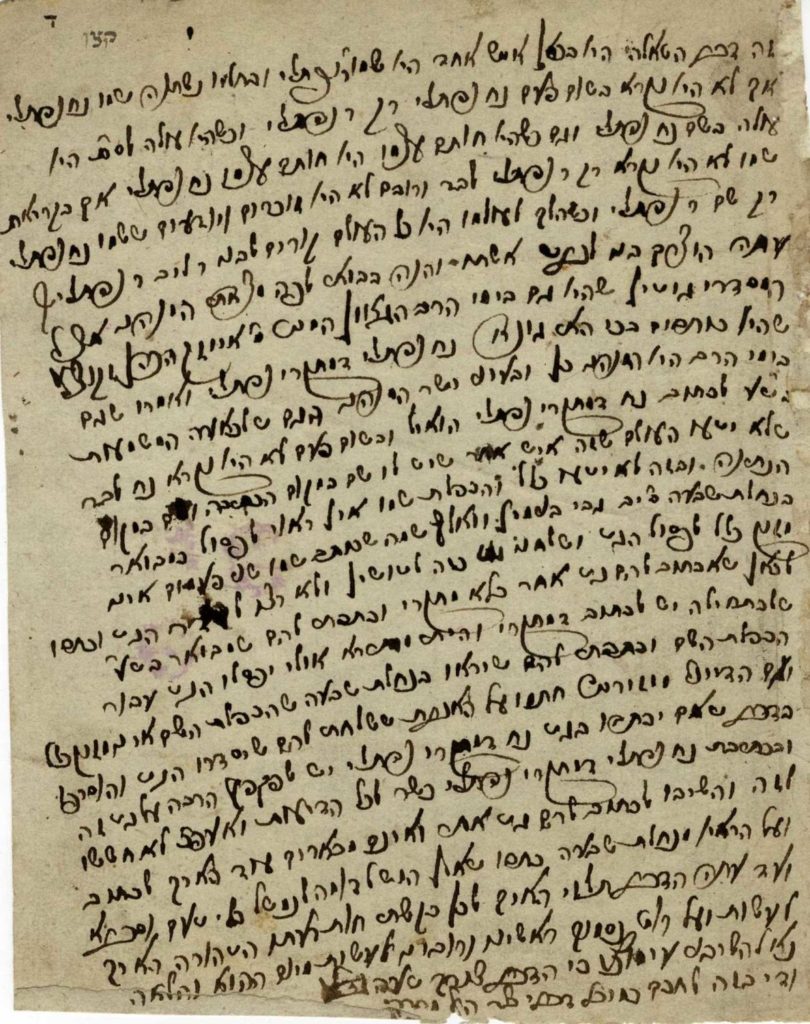
Question regarding names for a divorce document, from the holy gaon Rabbi Mordechai of Korets, father-in-law of Rabbi Yosef of Turchin, son of the holy Chozeh of Lublin. Sent to his cousin, Rabbi Ephraim Zalman Margoliot, the “Beit Ephraim.”
The response to this question appears in the Beit Ephraim , Gittin, siman 109, and it opens with the note that it was addressed to the Korets community. An additional proof of the writer’s identity is the remark in this letter, “I found the custom by those who arranged divorces, also in the times of … Isaac HaKohen ztz”l.” This is a reference to the author of the Brit Kehunat Olam who was Av Beit Din in Korets.
Rabbi Mordechai of Korets was the son of Rabbi Pinchas, Av Beit Din of Kalk, son-in-law of Rabbi Mordechai Margaliot of Brody, grandfather of the Beit Ephraim, so that the correspondents were cousins. He was appointed rabbi in Korets in 1798. He signed many approbations, including ones in which he is addressed with many enthusiastic honorifics. He gave approbations together with prominent disciples of the Besh”t and the Maggid of Mezeritsch to important works such as Ohr Torah , by the Maggid of Mezeritsch; Ohr HaMeir , by Rabbi Zeev of Zhitomir; Kedushat Levi by Rabbi Levi Yitzchak of Berditchov.
His only daughter was married to Rabbi Yosef of Turchin, son of the Chozeh of Lublin. (In an approbation to Ohr Pnei Moshe , Rabbi Mordechai mentions a visit to the Chozeh of Lublin: “When I arrived in Lublin to the study hall of the G-dly, holy person, Moreinu Rabbi Yaakov Yitzchak HaLevi, may he live forever …”)
Disciples of the Chozeh of Lublin considered Rabbi Yosef his father’s successor but, he passed away soon after, in 1818.
Rabbi Mordechai passed away on the 13th of Tammuz 1822. In recent years, a new mausoleum has been constructed over his grave in Korets.
[1] leaf, ink on paper, 22×18 cm, 25 lines in his holy hand. Fine-very fine condition. A expert’s authorization of the writer’s identity is included with this lot.
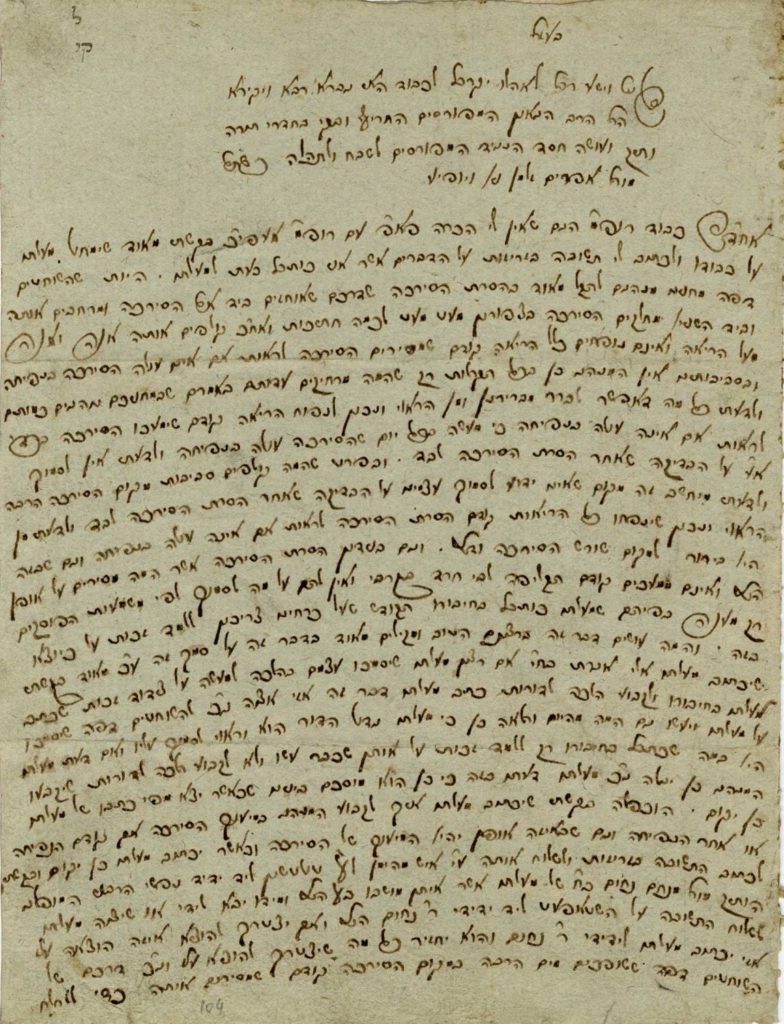
Halachic question regarding removal of defects in the lungs by ritual slaughterers, addressed to Rabbi Ephraim Zalman Margoliot, author of Beit Ephraim .
The writer was the holy Torah genius, Rabbi Daniel David son of Rabbi Shemarya Shmerel of Verchibka [וורחיבקא].
Rabbi Shmerel had no sons, only daughters. The story is told, in the name of his son-in-law, Rabbi Falk HaKohen of Ṭshiṭelniḳ, that the Besh”t often stayed at Rabbi Shmerel’s home, and every time he came, all the women would leave the house in his honor. Rabbi Shmerel wanted a blessing for a son from the Besht, but was too embarrassed to ask. After a few visits, the Besh”t told Rabbi Shmerel to call his wife. When she arrived, the Besh”t told her that she would merit a son that year. And so it was, a son was born and was named David Daniel (author of this letter).
Every time a daughter was born, Rabbi Shmerel traveled to his rebbe, the Besh”t, and received a protective amulet from him. When his son was born, the Besh”t told him that he would lose his money. He had a choice: a son or wealth, and he had chosen a son. Rabbi Shmerel had been extraordinarily wealthy, but he lost his property and was taken on as preacher in Verchibka and as a rabbi in Savran. (Refer to Shivchei HaBesh”t , p. 99-100.)
The letter opens with the words, “I ask very much that he write me an answer quickly … since the slaughterers here are customarily very lenient when removing this defect … and they say that his honor wrote in his holy work as such … and they are very lenient with this, relying on this statement. Therefore, I ask that his honor write to me, if he so desires, that they should learn more practical halachah … to designate the halachah for generations … and then I will also instruct the slaughterers here that they can rely on his honor and also do from now on as such, because his honor is the leading Torah personality of the generation and it is proper to rely on him. And if his honor believes that what he wrote in his work is only to be able to favorably judge those who already acted accordingly, and does not determine halachah for future generations, his honor should reveal his opinion on this matter. We have agreed that whatever his honor says will be upheld.”
Later on in the letter, he asks that the answer be sent “by a trustworthy person … through my soul friend … Menachem Nachum.”
[2] pages, ink on paper. 23×17 cm. 36 lines in the pleasant, clear hand of the rabbi, with his signature at the conclusion. He addressed Rabbi Ephraim Zalman with nine lines of amazing honorifics on the back of the envelope.
The answer to this question was printed in Shu”t Beit Ephraim , Yoreh Deah, siman 24.
Very fine condition. Traces of wax on the back of the letter. Tear in the margins of the letters, blemishing a number of words written on the back. Report by a manuscript expert included with the lot.
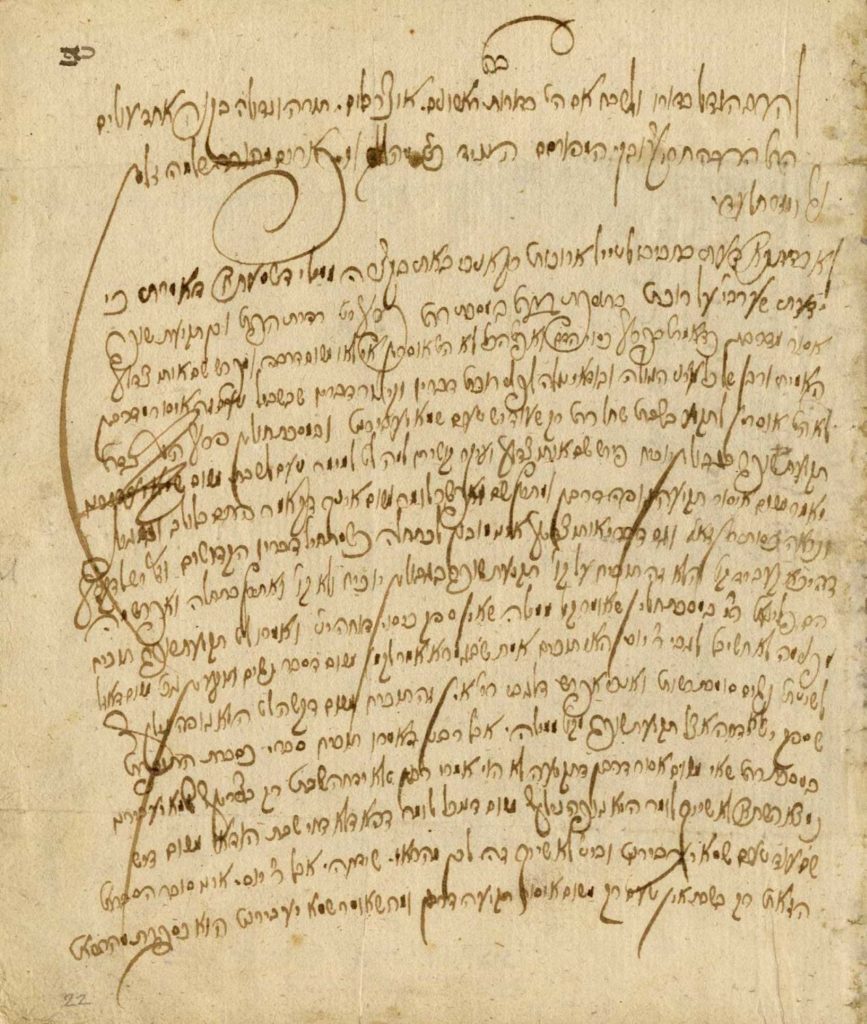
Letter sent by the first Admor of Narol, Rabbi Yaakov Reinman. Entirely in his holy hand and with his signature. Sent to the famed Torah genius, Rabbi Ephraim Zalman Margoliot; includes an insight regarding the Tosafot in Tractate Rosh Hashanah.
Rabbi Yaakov Reinman was one of the first Admors in Galicia. Born in 1778, his father was Rabbi Mordechai of Sokal, brother of Rabbi Shlomo of Lutzk, author of Dibrat Shlomo. He was a son-in-law of Rabbi Leibush Wallerstein Yaffe of Halshitz [Holishits], whose glosses were printed in a number of editions of the Shulchan Aruch Yoreh Deah.
He was orphaned of his father at a young age and was educated by his uncle, author of Dibrat Shlomo . It is related that at the age of 12, his teacher caught him rolling in the snow at the edge of the village. The boy promised his teacher that he would merit a long life if he wouldn’t reveal what he had seen. The teacher lived to be over 90 years of age.
He was very knowledgeable in both the hidden and the revealed Torah and was known for his self-afflictions. He was a disciple of the Chozeh of Lublin who sat him next to him at the table and said that the trip from Lublin to Narol was illuminated by him.
At the age of 20, he was already appointed rabbi of Kozowa, and then of Radichow. He took over his father-in-law’s position in Halshitz for a while, before being appointed rabbi of Narol where he served as Admor. He is famed for the guarantee he gave the residents of Narol that a fire wouldn’t break out in the city for 100 years. In fact, until 1914, exactly 100 years after his passing, there were no fires. The Divrei Chaim of Sanz – walked by foot to visit him about 3-4 times. Rabbi Shimon of Jaroslow, who was blind, came for a visit. When he arrived, he told his helpers to move to the side, saying “I don’t need you now, the light of Torah is illuminating things for me here.” He passed away at the young age of 36, on the 4th of Tammuz 1814. His progeny were Admors in Narol until the Holocaust. (Alfasi, 249, Meorei Galicia , p. 959).
[2] pages. Ink on paper. 20×17.5 cm. 32 lines written and signed by the Admor. He added another five lines on the back of the letter, with extensive honorifics for the addressee, the Beit Ephraim.
Fine condition. Professional restoration in the fold marks, affecting only solitary letters. Aging stains.
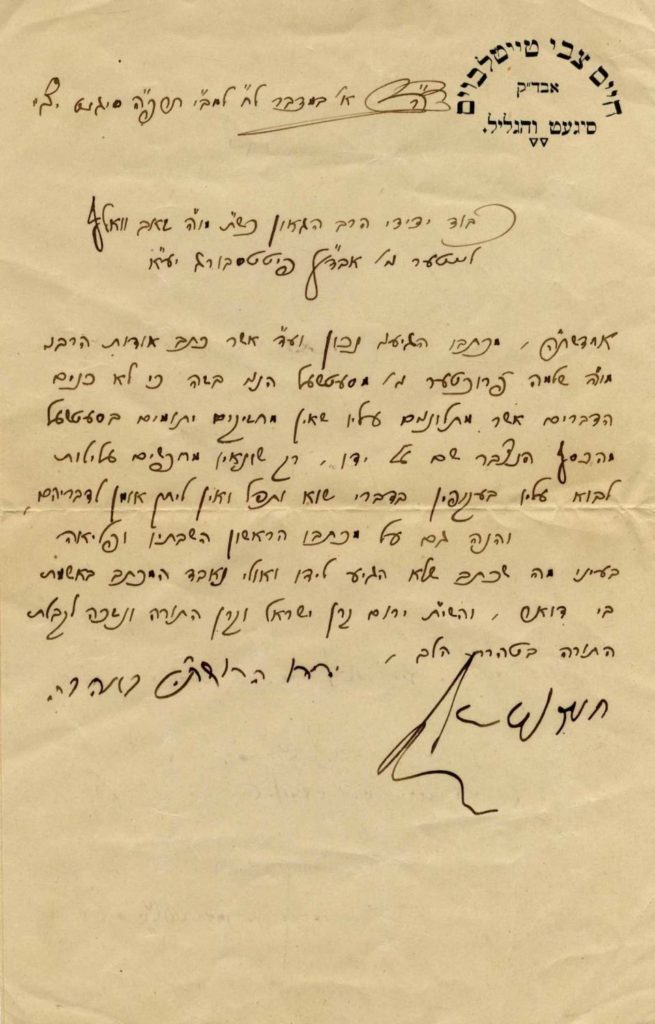
“… Only his enemies seek plots to come to him circuitously with false words, and one shouldn’t trust their words …”
Letter to Rabbi Zeev Wolf Leiter Av Beit Din of Pittsburgh, dated the 23rd of Iyar, 1925 (17.5.25).
In this letter, the author of Atzei Chaim defends Rabbi Shlomo Fruchter of Săcel who was accused of stealing charitable funds for orphans.
Rabbi Chaim Tzvi Teitelbaum, the Admor of Sighet, (1880-1926), “the great person, the giant, the glory of Israel, Admor HaRav HaGaon, the great, holy, noted for his Torah and wisdom in all corners of the world … Maran Chaim Tzvi Teitelbaum, Av Beit Din of Sighet” (quote from the title page of his work), was an outstanding genius and it was said that he never forget anything that he learned. He was one of the leading Admors in his generation and a leader of Hungarian Jewry. He taught hundreds of disciples and masses flocked to him.
He was born in 1880 to his father was Rabbi Chanania Yom Tov Lipa Teitelbaum, author of the Kedushat Yom Tov and son of the author of Yitav Lev. He was the son-in-law of Rabbi Shalom Eliezer Halberstam of Ratzfert, son of Rabbi Chaim of Sanz. In 1904, he succeeded his father in the Sighet rabbinate and in the chassidic court – when he was only 24 years old. He suffered a cerebral hemorrhage when he was with his followers in Kleinvarden, at only 46 years of age, in 1926. His works on the Talmud, Torah and festivals are called Atzei Chaim.
[1] double leaf. Ink on paper. 23×15 cm. Written by a scribe, with an added line and signature in the Admor’s hand.
Very fine condition. Fold mark.
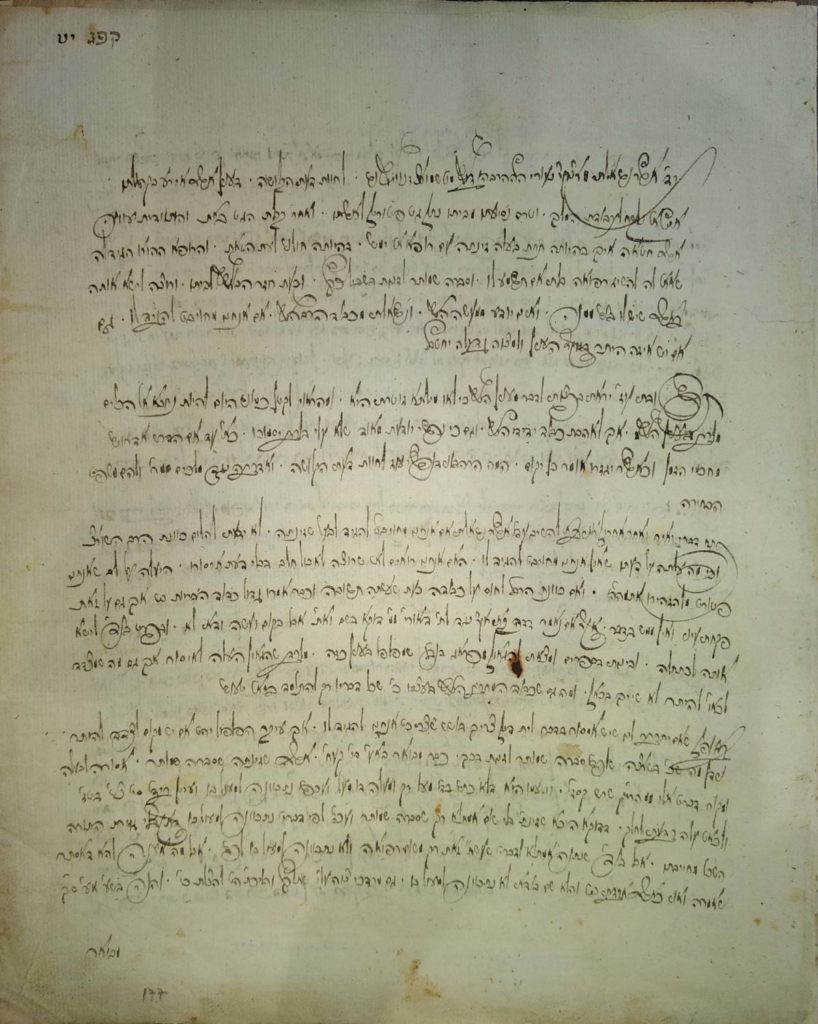
Detailed responsum involving a married woman who had an affair with a doctor and the discussion of whether it is necessary to inform her husband. Written on the Tuesday, Lag BaOmer, [1811]. This responsum was not printed in Shu”t Meishiv K’Halachah .
The responsum was written per the request of “The captain of my youth … the great rabbi … Shmuel Zanvil … to ask the opinion of my weak mind … regarding the episode that occurred in his congregation.” A similar response was printed in the Beit Ephraim , Even HaEzer, siman 127.
The author, Rabbi Avraham Zeev Wolf Frenkel (1780-1849) was the son of Rabbi Binyamin Poshaver, about whom Rabbi Naftali of Ropsitz said that he doesn’t have nearly as many hairs on his head as the amount of mitzvahs that Rabbi Binyamin has. As a young child, Rabbi Zeev was already recognized as a genius and diligent Torah scholar. At first he studied at Rabbi Menachem Mendel of Linsk’s kloiz, and then he moved to Zamosc to learn with Rabbi Mordechai Rabin. He became the son-in-law of Rabbi Avraham Moshe of Przeworsk, and through his efforts his young son-in-law received the honorable position as rabbi and Av Beit Din in the city. He served in this position until the passing of his young wife. He then married the daughter of Rabbi David HaLevi Notenhausen, who was the rabbi of the tailors in Broyde, and he moved to be supported by his father-in-law in Broyde. He served as dayan there alongside Rabbi Ephraim Zalman Margaliot, author of Beit Ephraim , and this responsum is addressed to him. He later moved to Reishe [Rzeszów], where he lived for close to 30 years. There he earned the surname “Reischer.” He refused to accept a rabbinical position in the city. In Reishe, he married his third wife, the daughter of Rabbi Yaakov Kuttelberg, son-in-law of Rabbi Shmelke of Nikolsburg. He became very wealthy and was considered a great philanthropist. He was famed for the vast amounts of money he distributed to charitable causes. He made sure “that every child has food to eat and clothes to wear.” He received questions from people around the globe, including the Shoel U’Meishiv and the Divrei Chaim. When he was in Reisha, there was a controversy regarding the rabbinate in Ropshitz. They turned to Rabbi Zeev for a decision, and he wrote a responsum that made a powerful impression.
He spent much time in the courts of the chassidic leaders of his time. As a youth, he sought out the Chozeh of Lublin and Rabbi Menachem Mendel of Rimanov. When he was older, he was close to the Sar Shalom of Belz, Rabbi Tzvi Hirsch of Rimanov and Rabbi Asher Yeshayah of Ropshitz. His grandson wrote, “Whoever did not see his lowness and brokenheartedness after returning from these righteous people, has never seen a humble person in his life.”
[7] pages, ink on paper, 19.5×24.5 cm, about 160 lines in his holy hand and with his signature, clear, legible script. Fine condition. Aging stains, minimal professional marginal restorations. An expert confirmation of the identity of the writer is included with this lot.
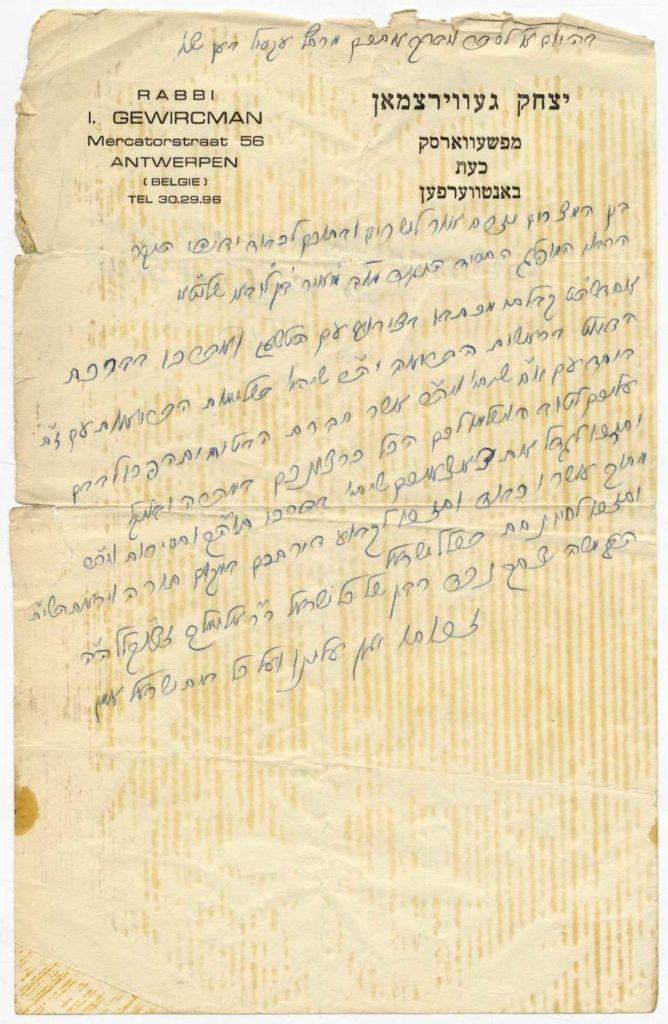
Letter of blessing from the Admor Rabbi Itzikel of Pshevorsk. Aix-les-Bains, France.
[2] pages, ink on official paper. 14×21 cm. 15 lines in his handwriting, and with his signature.
The Admor signs his name: “The small one, Moshe Yitzchak, grandson of the rabbi of all Israel, Rabbi Elimelech Ztzukllh”h.” On the reverse side of the page, the Admor added an additional sentence and blessing, and signed as mentioned.
The Admor Rabbi Moshe Yitzchak Gwirtzman of Pshevorsk [1882-1976], was the primary disciple of Rabbi Yechezkel of Shinova, firstborn son of the author of Divrei Chaim of Sanz and descendant of the author of Noam Elimelech , which he mentioned in his signature. There were righteous people who saw him as a faithful successor to his illustrious ancestor. He resided in Pshevorsk, hence he was known as Rabbi Itzikl of Pshevorsk. He was exiled to Siberia during the Holocaust. He later returned to Poland, moved to France, and then to Antwerp by instruction of the Admor, Rabbi Aharon of Belz. He was known as a miracle worker and thousands of people flocked to him from across the world. He was also known for the charity he gave. He passed away on Yom Kippur of 1976. See his biography in Roeh Even Yisrael [Brooklyn 1989], and some of his Torah thoughts in Siach Yitzchak HaChadash [London 2011].
Moderate-fine condition. Minor tears to white margins without damage to text. Stains.
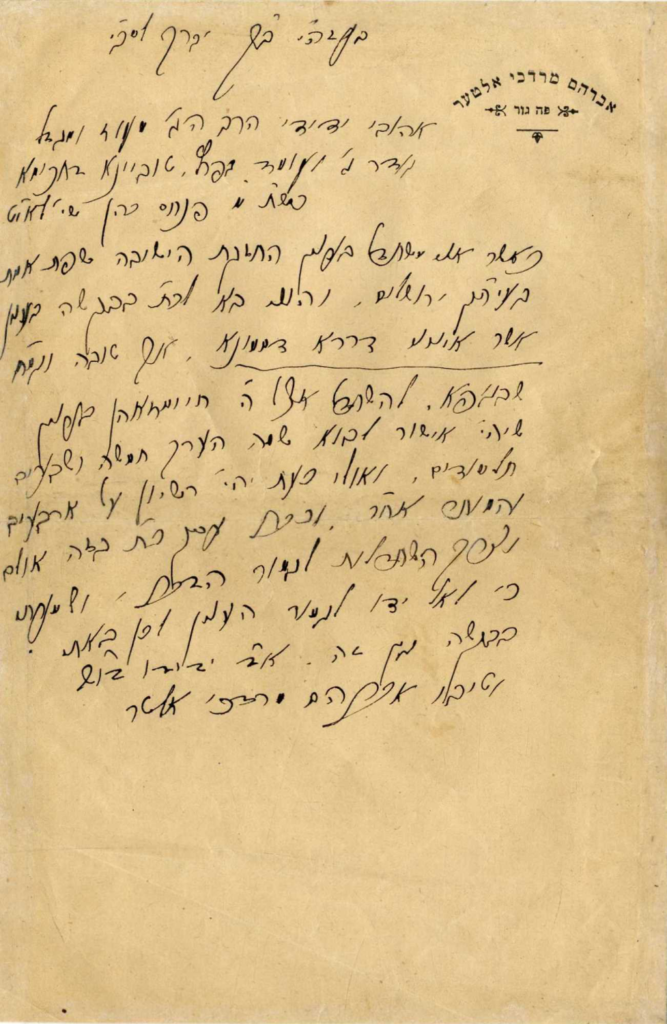
Letter from the Admor Rabbi Avraham Mordechai Alter of Gur, about the Sfat Emet yeshivah . Gur [late 1920s?]
The letter concerns assistance getting a permit for the Sfat Emet yeshivah in Jerusalem. The Sfat Emet Yeshivah was founded in 1925, and was one of the first chassidic yeshivahs in the Land of Israel. The letter was sent to ‘Rabbi Pinchas Cohen,’ [apparently] Rabbi Pinchas Cohen, rabbi of Ansbach, one of the founders of Agudat Israel in Poland, and a leader of the International Agudat Israel, whom the Admor highly extolls.
Rabbi Avraham Mordechai Alter [1866-1948], the author of Imrei Emet of Gur, firstborn son of Rabbi Yehudah Leib Alter, the Sfat Emet. He served as Admor of the Gur chassidut and one of the leaders of chareidi Jewry as a whole for 43 years. In his day, Gur chassidut reached its peak. There are those who estimate that the number of his chassidim before the Holocaust at more than one hundred thousand.
[1] double leaf, ink on official paper. 14×21 cm. Entirely in his handwriting and with his signature.
Very fine condition. Professional restoration in the margins.
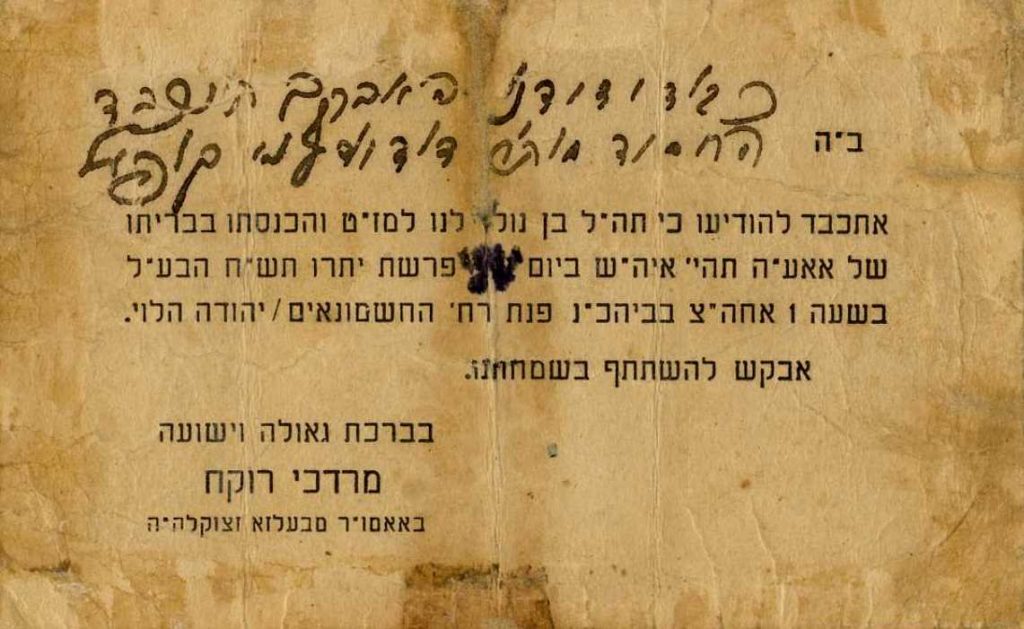
Invitation to the Admor of Belz shlit”a’s circumcision , with the name of the person invited written by the Admor’s father – the Rebbe of Bilgoray.
Printed invitation with additional text written by Admor Mordechai Rokeach of Belz: כבוד ידידנו האברך הנכבד החסיד מוה”ר דוד יוסף נ”י קופעל.
Rabbi Mordechai Rokeach of Belz [1901-1949] was the Rebbe of Bilgoray, the son of Admor Yissacher Rokeach of Belz. He married into the family of Rabbi David Shlomo of Kobrin. After his father’ passing, he was appointed rabbi and Av Beit Din in Bilgoray, and humbled himself before his brother, the Admor. During the Holocaust, he was smuggled out of danger together with his great brother by his chassidim. After many tribulations, they reached Tel Aviv in 1944, where he helped his older brother restore the chassidut. After learning that his wife and children were all murdered, he remarried. His son [the subject of this invitation] was born in 1948, eventually becoming the Admor. In 1950, he took ill and passed away suddenly at only 48 years of age.
12×7 cm. Moderate-fine condition. Aging stains and fold marks.
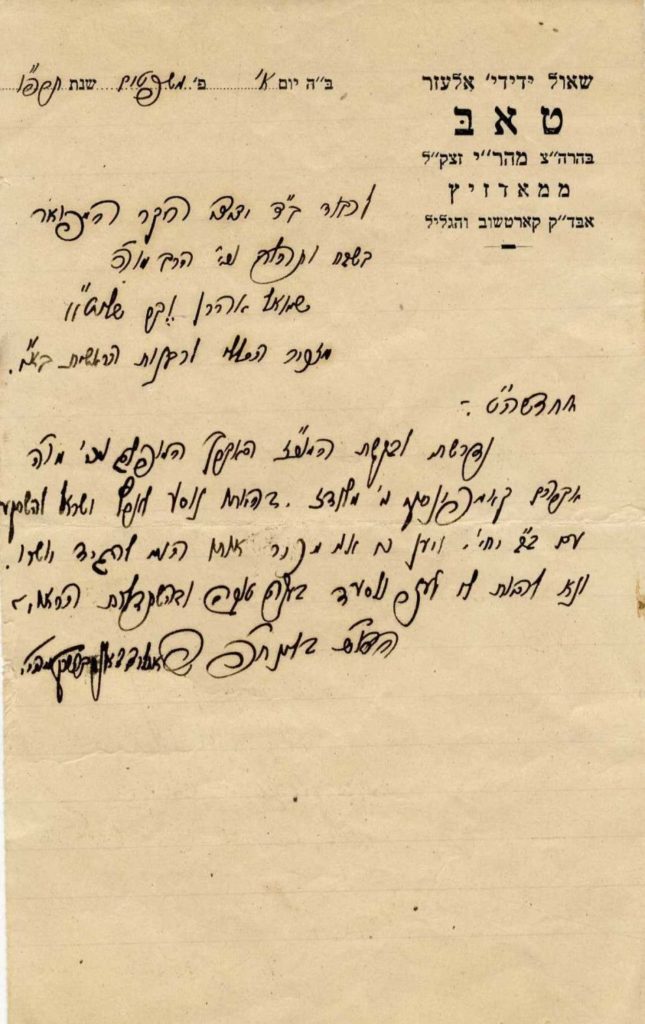
Handwritten and signed letter by the Admor Rabbi Shaul Yedidyah Elazar Taub, the second Admor of Modzitz. Krauszów , 1926.
As part of his numerous efforts helping Jews return to the Land of Israel, the Admor approached Shmuel Aharon Weber to request his assistance in the absorption of a chassid who intended to immigrate to the Land of Israel and settle there.
“The prominent Torah scholar, Rabbi Avraham Kampinski of Lodz … is traveling to the Land of Israel to settle there with his family. I know him personally and attest to his integrity …”
Admor Rabbi Shaul Yedidyah Elazar Taub [1887-1947] was son of Rabbi Yisrael Taub, the founder of the Modzitz dynasty. In 1917 he was appointed rabbi of Rakow, and following his father’s passing in 1921, began serving as Admor. About a year later, he was appointed rabbi of Krauszów. In 1929, he moved to Otwock, near Warsaw, where he established the Tiferet Yisrael yeshivah. Many chassidim and admirers from all over Poland flocked to his court. On the High Holy Days he was accustomed to pass before the ark. He was known for his musical compositions, which gained fame already in his youth. He would highly praise the Land of Israel, and encouraged his listeners to make aliyah and participate in its reconstruction. The Admor himself visited the Land of Israel several times, and on one of his visits he even met with the British High Commissioner Herbert Samuel.
At the outbreak of World War II, he fled to Vilna and managed to escape to the United States. During his stay in Vilna he composed melodies reflecting the Jewish people’s terrible tragedy during the war. He passed away in 1948 in the Land of Israel. His Torah teachings are written in the books Imrei Shaul and Yisa Brachah. His son Rabbi Shmuel Eliyahu Taub, the ‘Emrei Esh,’ was appointed in his place, and established a study hall in Tel Aviv.
[1] leaf, official paper. 12×19 cm. Very fine condition.
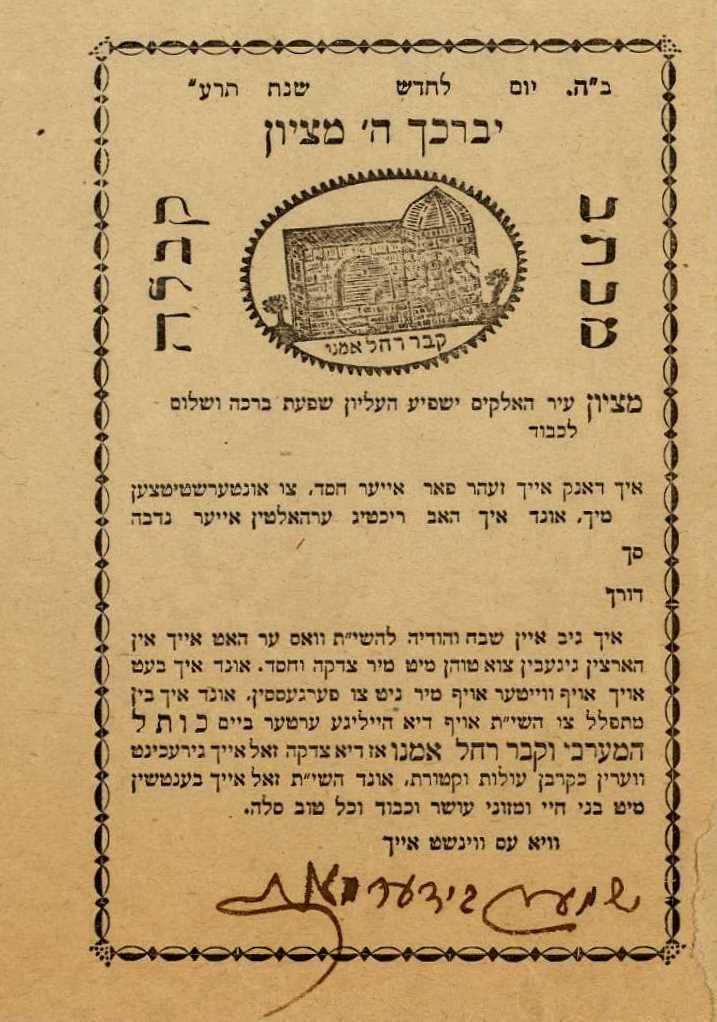
“Yivarechecha Hash-m MiTzion” r eceipt with a printed thank-you letter from Jerusalem, early 20th century, with illustration of Rachel’s Tomb. Concludes with the Admor’s signature.
The printed Yiddish text blesses the donors and promises to pray for them at the holy sites, the Western Wall and Rachel’s tomb.
Rabbi Shimon Nota Biderman (1869-1930) was the fifth Admor of Lelov, a sage at the Shaar HaShamayim yeshivah. He visited Poland and often stayed with his Rebbe, Rabbi Yisrael Perlow of Stolin. During his last visit, he settled in Krakow and accepted the mantle of Admor. He returned to Land of Israel 13 years later, in 1926. His father’s chassidim and chassidim from other courts gathered around him. Letters with his signatures are very rare, most of his known letters were written for him by his son, Rabbi Moshe Mordechai of Lelov.
Size: 11×9 cm. Very fine condition.